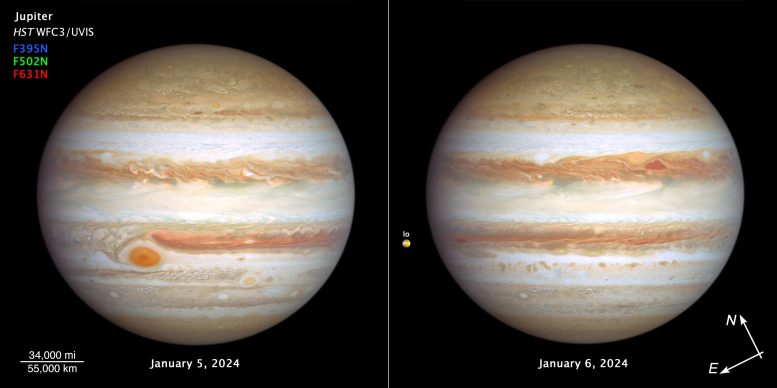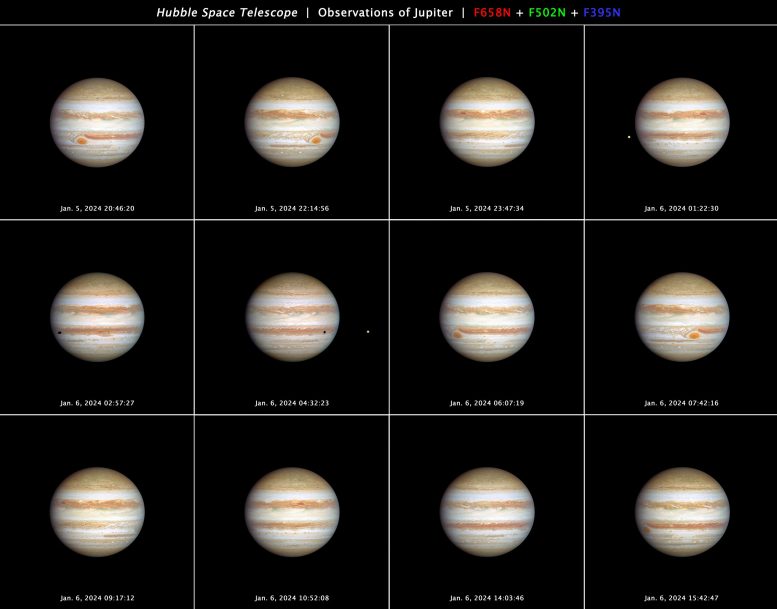NASA's Hubble Space Telescope captured new images of Jupiter on January 5-6, 2024, revealing dynamic weather patterns and notable storms such as the Great Red Spot and Red Spot Junior. The observations are part of the annual Outer Planet Atmospheres Legacy project. Volcanic activity and surface features of Io. Credit: NASA, ESA, STScI, Amy Simon (NASA-GSFC)
Hurricanes, wind shear, violent storms in Jupiter's atmosphere
The largest and closest of the giant exoplanets, ThursdayIts colorful clouds offer an ever-changing kaleidoscope of shapes and colors. It is a planet with always stormy weather: hurricanes, anticyclones, wind shear and the largest storm in the solar system, the Great Red Spot.
Jupiter has no solid surface, and is permanently covered by ammonia ice-crystal clouds about 30 miles thick in an atmosphere tens of thousands of miles deep and giving the planet its banded appearance.
Bands are produced by winds flowing in different directions at different latitudes at speeds of up to 350 miles per hour. The lighter areas where the atmosphere rises are called zones. The dark areas where the wind falls are called belts. When these opposing currents interact, storms and turbulence appear.
Hubble tracks these dynamic changes with unprecedented clarity every year, and there are always new surprises. The many large storms and small white clouds seen in Hubble's latest images are evidence that there is a lot of activity going on in Jupiter's atmosphere right now.

Jupiter is built in stripes of brownish orange, light gray, soft yellow and cream colors. Many large storms and small white clouds stop the planet. The largest storm, the Great Red Spot, is the most prominent feature in the lower left third of this scene. To its lower right is a small reddish anticyclone, Red Spot Jr. Another small red contrast appears near the top center of the image. At the top right of center in the right image, a pair of storms appear next to each other: a deep red, triangular-shaped tornado and a red anti-storm. Towards the lower left edge of the image is Jupiter's small moon Io. The colorful orange color means that volcanic outflow sediments are found on Io's surface. Credit: NASA, ESA, Amy Simon (NASA-GSFC)
The Hubble Space Telescope monitors Jupiter's stormy weather
The giant planet Jupiter, in all its glory, is revisited NASAs Hubble Space Telescope In these latest images, both sides of the planet were captured on January 5-6, 2024. Hubble observes Jupiter and other outer solar system planets every year Outer Planet Atmospheres Legacy Program (OPAL). Because these large worlds are surrounded by clouds and stirred by violent winds, causing an ever-changing kaleidoscope of weather patterns.
[left image] – Big enough to swallow Earth, the classic Great Red Spot stands prominently in Jupiter's atmosphere. To its lower right, at a higher southern latitude, is a feature sometimes called the Red Spot Jr. This anticyclone is the result of combined storms in 1998 and 2000, and it first appeared red in 2006 and then turned light brown in subsequent years. It's a bit red again this year. The source of the red color is unknown but may include a variety of chemical compounds: sulfur, phosphorus, or organic matter. Staying in their paths, but moving in opposite directions, Red Spot Junior passes the Great Red Spot every two years. Another small red anticyclone appears in the far north.
[right image] – Storm activity also appears in the opposite hemisphere. A pair of storms, a deep red tornado and a reddish anti-tornado, appear next to each other to the right of center. They look so red that, at first glance, it looks like Jupiter's knees are skinned. These storms rotate in opposite directions, indicating an alternating pattern of high and low pressure systems. In the case of cyclones, clouds at the edges descend in the middle, removing atmospheric fog.
Credit: NASA's Goddard Space Flight Center, Lead Producer: Paul Morris
The storms are expected to pass each other because their counterclockwise and counterclockwise rotation repels each other. “Many large storms and small white clouds are a sign of a lot of activity in Jupiter's atmosphere right now,” said Amy Simon, Opal project manager at NASA's Goddard Space Flight Center in Greenbelt, Maryland.
The Galilean moon on the left edge of the image, Io – is the most volcanically active body in the Solar System, despite its small size (slightly larger than Earth's Moon). Hubble resolves volcanic outflow deposits on the surface. Hubble's sensitivity to blue and violet wavelengths clearly reveals interesting surface features. of NASA in 1979 Voyager 1 The spacecraft discovered Io's pizza-like appearance and volcanoes, surprising planetary scientists because it's a small moon. Hubble picked up where Voyager left off, tracking the restless Io year after year.
The Hubble Space Telescope images used in this animated science visualization present a complete rotation of the giant planet Jupiter. It's not a real-time movie. Instead, Hubble snapshots of the colorful planet taken on January 5-6, 2024, were photographed on a sphere and rotated in model animation. The planet's actual rotation rate is about 10 hours, which is easily plotted by watching the Great Red Spot come and go during each completed rotation. Hubble observes Jupiter and other outer solar system planets every year under the Outer Planet Atmospheres Legacy Project (OPAL). Credit: NASA, ESA, Amy Simon (NASA-GSFC), Joseph DePasquale (STScI)
The Hubble Space Telescope has been operating for more than three decades and continues to make new discoveries that shape our fundamental understanding of the universe. Hubble is a project of international collaboration between NASA and ESA (European Space Agency) NASA's Goddard Space Flight Center in Greenbelt, Maryland manages the telescope. Goddard is working with Lockheed Martin Space in Denver, Colorado. The Space Telescope Science Institute (STScI) in Baltimore, Maryland, runs Hubble and Webb science operations for NASA. STScI is operated for NASA by the Association of Universities for Astronomical Research in Washington, DC.

This 12-panel series of Hubble Space Telescope images taken January 5-6, 2024, provide snapshots of the giant planet Jupiter's entire cycle. The Great Red Spot is used to measure the planet's true rotation rate of about 10 hours. The innermost Galilean satellite, Io, is seen in many frames as its shadow crosses over Jupiter's cloud cover. Hubble observes Jupiter and other outer solar system planets every year under the Outer Planet Atmospheres Legacy Project (OPAL). Credit: Amy Simon (NASA-GSFC)